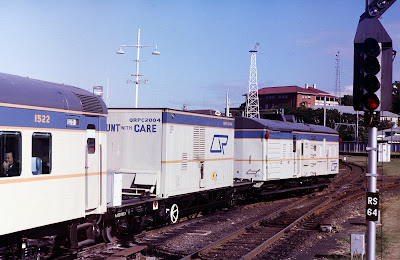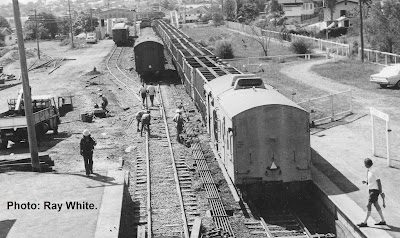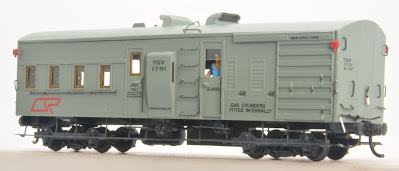Prototype Information:
With rebuilding of the rollingstock fleet after WW 2 in the early 1950’s, construction of wagons and carriages moved from wood to steel. It was not until 1970 that steel goods Guard Vans entered service.
From the early 1950’s to the early 1960’s steel underframe wooden frame vans of the BBV class were built in various contracts. The last being for the upgrade of the Mt Isa Line in 1961. The mid 1960’s saw an explosion of contracts for Central Queensland coal to be transport to Gladstone. This started off with trains on the Moura Short Line, 60 VO class bogie wagons (3,780 Tons approx.) being hauled by three locomotives. The ride at the rear of the train for the Guard was a shocker with many receiving injuries. At first a number of BBV vans had padding installed in the Guards compartment. As the traffic grew into the Blackwater area a number of BBV vans were modified and fitted with periscopes. This moved the Guard away from the side lookouts to the centre of the van with a view over the top of the train.
The need to carry passengers and goods in Guard Vas was also changing. This type of work had been moved to select trains in the time table with allocated wagons and vans. Running of trains at times required Train Crews to travel spare or passenger, in other words there was no train for them to work back to their home-depot. The next train back could be days away requiring crew to have lengthy time in away from home-depot. Keeping crews away from home costs money and is not much chop for the family environment and life in general. Many at weekends crews would work a train to the next change location and then catch the next train home at passive pay rates. The van on these trains could be anything, if bit of lucky the van had long seats across the van that allow the crews to laid down and have 40 winks or so on the way back home. But there were no facilities, no toilet or any way of making a cup of tea. If it was a regular working, TCW (Traincrew Camp Wagon) could be used, but this was an extra vehicle on the train and shunting was needed.
With the introduction of the steel TGV (Traincrew Guards Van) issues of the day were addressed. They were vans that could be used on heavy coal trains, carry some freight and accommodate a train crew travelling spare with some facilities that allowed them to rest. There were times where crews would leave their home- depot travelling spare to work a train back home.
Externally
the vans were 36 ft. (10 970 mm) long and 8ft. 6 ins wide, 9 ft. 6 ins (2 895
mm) across the Guard’s lookouts. The vans were 12 ft. 9¾ ins high to the top of
the periscopes. The average tare weight was 19 T 15 cwt with a gross weight of 25
T. The capacity was to carry 3 tons for goods, 12 seating or 3 sleeping
passengers (crew). The unit length for train marshalling was 2.3 units. Roller
bearing fabricated plate frame bogie with 760 mm dia. wheels at 6 ft. centres
gave the van a very smooth ride. Drawgear consisted of buffer, auto couplings
and transition links.
TGV Vans;
1971
(#’s 1756 – 1758).
1973
(#’s 1779 – 1790).
1975
(#’s 1971 – 1803).
1977
(#’s 1809 – 1824).
In
1983 TGV 1783 and 1813 were modified for the Daylight Rail Tours and were
painted is A/c Train colours and reclassed to MBV.
Loading suitcases/bags to the luggage compartment (previous a crew area) through the ante room with doors would of be a ton of fun ?? I hope all the platforms were on the other side.
Both
photos were taken at Rockhampton yards with vans coupled to freight wagons. Daylight
Rail Tours trains only run in the cooler months of the year. I could not see them
sitting in the Mayne Car Shed for 6 months waiting for the next season to
start. I wonder if they worked other
trains in the off season. Your comments would be greatly appreciated if you
have knowledge of them on freight services.
P&O Fisherman’s Island – City Shuttle.
Mackay Heritage Railway Crew Car
Over time four different classes and types of the vans in the same body shape entered service.
TGVS Vans; were same
as the TGV van except fitted with a sliding centre sills, due to this
arrangement, the vans could not be fitted with transit couplings or coupler
release levers and could only be coupled to rollingstock fitted with auto
couplings. The sliding centre sill absorbed some the train draft forces making
them more suitable for long coal trains operations in CQ.
1971/2
(#’s 1759 – 1776, 1778),
1978/9
(#’s 1855 – 1860, 1862 – 1872, 1874),
1983
(#’s 1921 – 1926).
Unloading Fisherman’s Islands.
Turning the corner at Yeerongpilly.
TGVH Vans; 1976
((#’s 1804 – 1808) were built for the Phosphate Hill Traffic and were fitted
with a roller door on the goods compartment instead of the usual sliding door.
The goods compartment could carry 6 tons as the 3 tons on the other vans. The
vans were regularly observed working trains in other parts of the state
including the far South West on the “Flying Flea” between Charleville and
Quilpie.
TGVH 1807 Mackay. Note the larger door.
Train 3Q84 returning as 3S95 (old 98/99) “Flying Flea” Charleville to Quilpie twice weekly passenger service connecting with the Westlander. The train is crossing the Warrego River at Westgate. After the Westlander derailment at Bindango on the 06 Nov 1987, the “MPR” was replaced with a “PCR” Power Pack and “R” refrigerated Wagon. Wooden vans has also been replaced with steel vans by this time.
TDV Vans; The goods compartment area was made into a Drover’s compartment. The drover’s compartment consisted of a toilet, wash basin, gas cooking rings and a luggage compartment. The area could accommodated three drovers seating and two sleeping. The gas bottles were relocated and could be accessed from the side of the van.
1980
(#’s 1885 – 1990).
1981/2
(#’s 1911 – 1916)
A
number of TGV were converted to TDV’s. The
following numbers are shown on plans as being TDV vans, #’s 1817 – 1822, 1779 –
1782, 1757, 1785 – 1787, 1789, 1790, 1792, 1793, 1796, -1801, 1803, 1810 -,
1812, 1814.
TDV 1888.
TDV 1801 converted from TGV
These vans replaced the KKB, NB and NWB vans on cattle and sheep trains. Train Drovers would travel with the stock to their destination and would check the animals enroute to ensure they stayed on their feet for the journey. This was done mainly at locations where the trains would be stopping for some time. Crew change locations, crew meals and lengthy crossing of trains. If animals were found sitting on the floor of the wagon the drover would try to stand them up. If they were down for some time, other animals would walk all over them and end result was not good. Often when animal where down, the wagon would be shunted to the trucking yards where these animals would be removed from the wagon. The Station Master would advise the local butcher of animals fell behind.
With
the removal of Guard Vans from trains with Two Driver Operations (TDO) from
1985 onwards, vans conveying passengers/drovers etc. were move from the rear of
the train to the front. Flashing lights marked the end of the train. These vans
remained in service until the late 1990’s when checking of stock changed and was
carried out at set locations enroute.
Beaudesert
Cattle train returning to Brisbane at Coopers Plains during track work using
single line working, TGV 1756. Note the smart (white shirt with tie) Station
Master with the Coopers Plains – Sunnybank section staff in his hand.
TLV Vans; During
1978 -79 a longer TLV vans was built. (#’s 1825 – 1854). Having a body length
of 15 545 mm, the vans had a larger goods compartment (6 tons) and passenger
accommodation that could seat 9 and sleep 6 passengers. Two vans were converted
to A/C train vans (1853/1854) and reclassed to MTV. Three vans (1835, 1845,
1846) were converted into Traincrew Camp wagons and reclassed TCWA. Two vans
(1848/9) were modified to Loco Test Cars (LTC). Most of the other vans were
used in the construction of the GSPE train.
A number (five?) were converted
to EWT Electrification Work Wagons
Some vans live on after their
days on rails still providing accommodation.
The kit
was made available from Caintode Flats, previously manufactured by Far North
Hobbies the kit was been further enhanced and has been made available with the
additional parts to make a very nice model, these include brass etch running
boards (steps), loss wax castings, bogies and decals.
Couplers of choice required and paint to complete the
model.
Periscope shades and coupler release levers were added as
an extra.
Of late, Caintode Flats Models have been adding etch brass
steps and supports to their kits. Very nice detail including treads on the
steps. The steps are quite easy to solder into place.
The kit was completed without manufactures instructions, improvements with extra time could have produced a much better finish. The roof was a good fit, fitter was used to fill any small gaps. Suggest painting the model with a primer before the top finish coat, this will highlight were extra filler is require for a good finish. Don’t fall for the trap that paint will fill the gaps.
The van was painted with PGC QGR Freight Grey. The glass in the Guard’s lookout and periscope is black decal cut to size.
Decals were applied out in the sun on a hot day, a massive mistake (Grandson talk when Grandad has stuff up), Decals were drying out before reaching the model, likewise with the setting solution. Thus, a much better finish could have been achieved if I had used my normal work area. Each project you learn something new, that was so great about this hobby.
The van will be a welcome addition to the SWR and will feel right at home on the layout with diesel era trains after 1970. Yes, the rivet counter will find a couple of things not quite right, that’s model railways and availably of bits at the time, still an awesome model. I can see an MBV hitting the layout one day.
The kit will be released at the Brisbane Model Train Show 30th April, 1st May 2022 at the Brisbane Exhibition grounds. www.brisbanemodeltrainshow.com.au. But, wait I understand there will be MORE ??? Another model to suit both eras, steam and diesel that will go off like a bomb could also be available.
Bob
Harding of Wacol and Mosquito Creek fame converted one of the original kits to
a TDV vans for his later era cattle trains. The goods section was cut off and
replaced with a new styrene scratch built section as the drover’s compartment.
Enjoy
your modelling until the next post. Stay safe and well, Mr. Covid is still floating around.
Arthur H.
Acknowledgements.
Brake Vans of the
Queensland Railways 1864 - 1980 by John Armstrong.
QR Working Time Tables
QR Plans
Australian Model Railway
Association Queensland Library


.2.jpg)





















%20Mackay%2080's%20(P.%20Ford).2.jpg)
%20Gladstone%204-87%20(P.%20Ford).2.jpg)
%20Mackay%2015-7-01.2.jpg)

.2.jpg)









No comments:
Post a Comment